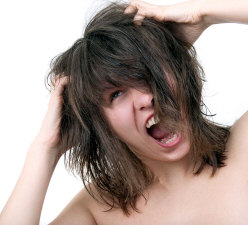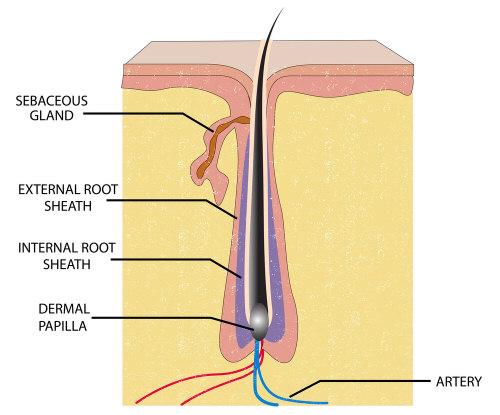What Really Causes Dandruff and How Can You Treat the Symptoms
 Dandruff in
the scalp can cause discomfort and embarrassment with the irritating
flaky white shedding of dead skin. Although dandruff is not usually a serious
condition, it can become chronic and has a potential to lead to secondary
infections like fungal and bacterial infection. Dandruff has no known cure but
the condition can be controlled using different treatment options depending on
the underlying factors that trigger it. The symptoms of dandruff may come and
go. Dandruff in
the scalp can cause discomfort and embarrassment with the irritating
flaky white shedding of dead skin. Although dandruff is not usually a serious
condition, it can become chronic and has a potential to lead to secondary
infections like fungal and bacterial infection. Dandruff has no known cure but
the condition can be controlled using different treatment options depending on
the underlying factors that trigger it. The symptoms of dandruff may come and
go.
What may be effective in treating symptoms of dandruff in one person may not
be so in another patient and therefore the right treatment option has to be
identified. Dandruff affects more men than women and is also more prevalent in
people with oily skin. A flaky scalp does not necessarily mean that you have
dandruff since there are other skin conditions that present similar symptoms of
dry flaking and itchy scalp such as eczema, psoriasis, rosacea, and seborrhea.
What is dandruff?
Dandruff also known as pityriasis simplex capillitii is a condition of the
scalp. Dandruff is a white flaking scalp that occurs as the dead skin cells are
shed from the scalp. Although it is normal for the scalp to shed its matured
cells, the rates at which these cells are shed may increase leading to more
accumulation of cells that die and flake off. This condition is characterized by
itching scalp and its severity may change with season and exposure to trigger
factors. Dandruff may also be confused with dry skin that can lease white flakes
of dead cells.
What really causes dandruff?
 The cause of dandruff is not clearly understood but the condition occurs when
skin cells grow and die fast that they are supposed to, causing accumulation of
dead skin that is shed off. Although it is not clear why this happens, it is
thought that a common fungus known as malassezia may contribute to the dandruff.
The exact cause of overgrowing malassezia that triggers formation of dandruff is
not well known. However, it is believed that the presence of too much oil on the
scalp, hormonal changes, neurological disorders like parkinson's disease,
stress, illnesses, not shampooing regularly, suppressed immune system, as well
as extra sensitivity to the malassezia fungus are some of the contributing
factors to the increased growth of the yeast-like fungus (malassezia) on the
scalp. The cause of dandruff is not clearly understood but the condition occurs when
skin cells grow and die fast that they are supposed to, causing accumulation of
dead skin that is shed off. Although it is not clear why this happens, it is
thought that a common fungus known as malassezia may contribute to the dandruff.
The exact cause of overgrowing malassezia that triggers formation of dandruff is
not well known. However, it is believed that the presence of too much oil on the
scalp, hormonal changes, neurological disorders like parkinson's disease,
stress, illnesses, not shampooing regularly, suppressed immune system, as well
as extra sensitivity to the malassezia fungus are some of the contributing
factors to the increased growth of the yeast-like fungus (malassezia) on the
scalp.
Malassezia fungus lives on the scalp of many healthy adults and does not
cause any serious problems. Nevertheless, if the immune system of patients with
dandruff overreacts to the fungus, it makes the dandruff symptoms worse.
Dandruff also tends to worsen when a person is stressed. Environmental
conditions like cold and dry winter are also likely to exacerbate or trigger
dandruff flare ups. Exposure to sunís ultraviolet rays may also induce the
condition.
Another condition that may lead to dandruff is seborrhea or seborrheic
dermatitis. Seborrhea is a chronic inflammatory disease that affects the skin
and is characterized by dry, greasy or moist scale with yellow crusted patches
on the scalp. Seborrheic dermatitis may appear as small scaly patches on scalp
and it progresses to involve the entire part of your scalp leading to excessive
exfoliation of dead skin cells or dandruff.
How does dandruff form?
Research has linked keratinocytes, the predominant cells in epidermis with
immunological reactions that lead to formation of dandruff. Keratinocytes form a
barrier on the skin, which protects the body from damages caused by things like
bacteria, viruses, fungi, parasites, ultraviolet rays, and water loss on the
skin. Keratinocytes are part of the cells that form the stratum corneum (SC)
layer of the skin.
The SC covers many parts of the body with extremely thin and soft biological
membrane that offers high efficient barrier for prevention of water loss from
the tissue. The stratum corneum is made up of tightly overlapping corneocytes,
and these corneocytes are composed of lipid-depleted and fully keratinized
epidermal keratinocytes.
Anatomy of hair:

Desquamatory enzymes in stratum corneum aid in daily individual exfoliation
of corneocytes, something that helps maintain the right thickness of the SC
layer. The time needed for the epidermis to proliferate and differentiate may be
shortened if the skin function is influenced by proinflammatory stimuli factors
that may be inflicted from inside or outside the body.
Such stimuli may lead to a stack of incompletely differentiated corneocytes
that have a less stratum corneum turnover compared to that of a normal skin. The
immature or incompletely differentiated corneocytes may be released to eliminate
harmful agents from the skin thus leading to accumulation of a mass of stratum
corneum layer. This layer forms the dry scales that are noticed in inflamed skin
lesions.
When there is quick turnover of the stratum corneum, it means that the slow
desquamatory process of stratum corneum does not take place and therefore a
formation of dry clumps of undifferentiated but firmly attached corneocytes
occurs on the skin surface. This way, dandruffs are formed.
The epidermal inflammatory reaction initiated to fight against Malassezia,
the fungus found in the sebum-rich skin surface may lead to formation of
dandruff. When the Malassezia globosa, a specific fungus found in scalp of both
healthy people and those affected by fungus, metabolizes triglycerides from the
sebum by expressing lipase, it results to release of oleic acid, a lipid by
product.
This oleic acid can cause the stratum corneum on the top layer of epidermis
to initiate inflammatory response, something that results to disturbances in
homeostasis thus causing an irregular cleavage of stratum corneum (SC) cells.
With dandruff, new cells are formed faster than they die resulting to more of
the skin being shed and therefore the white flaky scales are noticed on the
skin.
How can you detect that you have dandruff
 It's not difficult to tell if you have dandruff because you can see the
flaking skin cells. However, the symptoms could mimic other skin conditions. The
common sign of dandruff is the presence of white flakes that come out of the
scalp and could attach to your hair. In persons wearing dark clothes, these
flaking dead cells can be noticed when they fall on their shoulders. It's not difficult to tell if you have dandruff because you can see the
flaking skin cells. However, the symptoms could mimic other skin conditions. The
common sign of dandruff is the presence of white flakes that come out of the
scalp and could attach to your hair. In persons wearing dark clothes, these
flaking dead cells can be noticed when they fall on their shoulders.
A personís head feels tight and itchy. The head of a person with dandruff may
feel tingly and sore. The signs of dandruff may also vary from person to person
depending on the triggering factors such as seborrheic dermatitis. If dandruffs
are occurring due to a condition known as seborrheic dermatitis, a person may
have the white flakes of skin accompanied by red, flaky and greasy patches on
skin.
Because there are other conditions that mimic dandruff, this could lead to
misdiagnosis of the condition. The diagnosis of dandruff may be done by
examining the healthy history of a patient, the symptoms, and physical
examination of the scalp. If you have self-diagnosed yourself of dandruff and
applied treatment and it does not improve the symptoms such as shampoos, you
need to consult a dermatologist. A biopsy may be performed to help diagnose the
exact cause of the dandruff symptoms such as eczema, psoriasis, ringworms, head
lice, and possibly contact dermatitis.
How can you treat dandruff?
One thing for sure, there is no cure for dandruff but the most interesting
thing is that the symptoms can be managed thus making the condition subside or
even disappear. The treatment of dandruff will vary depending on its severity
and the causal factor. The most commonly used treatments are shampoos and
creams.
Using shampoos with ingredients like tar, salicylic acid, zinc pyrithione,
and ketoconazole may help treat this condition. If after using these shampoos,
the symptoms disappear, you can switch to regular non-medicated shampoos to help
cleanse the scalp and the follicles of dead cells and oils deposited on the skin
surface.
Similarly, if one shampoo does not work, you may try a different one.
Treating dandruff may take time and at times a trial and error approach may be
applied to determine the right treatment product that works for you. It is
important to consult a medical care practitioner or dermatologists when seeking
for treatment of the dandruff. This is because an underlying cause may be
worsening the symptoms for example, psoriasis or eczema.
 If dandruff is being induced by seborrhea, you may need to use creams such as
cortisones that help reduce inflammation and can be used together with medicated
shampoos. Although shampoos are the easiest to use in treating dandruff, the
limited contact time with the skin makes them less effective and may only be
used for mild cases of dandruff. If dandruff is being induced by seborrhea, you may need to use creams such as
cortisones that help reduce inflammation and can be used together with medicated
shampoos. Although shampoos are the easiest to use in treating dandruff, the
limited contact time with the skin makes them less effective and may only be
used for mild cases of dandruff.
Steroid solutions may also be used to treat inflammation but then again there
might not help in removing large scales of the dead skin. Creams and lotions can
help because they are left over the scalp for sometime or overnight thus being
able to dissolve the scales. Antifungal creams appear to be more effective since
they are able to reduce the number of the yeast-like fungus- malassezia, which
triggers episodes of dandruff.
Antifungal creams with 1% clotrimazole and 2% miconazole may be applied once
or twice a day to treat the condition. The tar shampoos can help reduce the cell
division, inflammation and itchiness. The salicylic acid shampoos help in
dissolving the dead keratinocytes and cleansing the follicles of the scales
faster. Steroid is suitable for cases of seborrhea dermatitis and psoriasis that
may be triggering dandruff.
Sulfur, ketoconazole, zinc pyrithion, and selenium sulfide found in shampoos,
creams and lotions helps in reducing the number of fungus that trigger the
formation of dandruff.
Besides the medicated shampoos, lotions, solutions, creams and ointments
there are also natural remedies that can help fight dandruff.
Natural remedies for treatment of dandruff
As said, treating dandruff may require different options and diet cannot be
eliminated from the treatment. The foods people eat can determine how well they
are able to manage dandruff formation. Eating foods that are rich in omega 3
fatty acids like fish can help fight the condition. Vegetables and fruits are
also good in dealing with this condition. You can control dandruff by taking
vitamin B and zinc diet supplements. Probiotics are good bacteria that you can
find in foods like yogurt and they can help in treating dandruff.
 There are also remedies that you can apply on scalp to treat dandruff
symptoms such as vinegar, honey, and tea tree oil. By mixing one part of apple
cider vinegar with one part water, it can provide a solution, which you can
apply on your hair and massage on the scalp. Remember that concentrated vinegar
can sting your scalp and you should ensure that it is diluted with water. There are also remedies that you can apply on scalp to treat dandruff
symptoms such as vinegar, honey, and tea tree oil. By mixing one part of apple
cider vinegar with one part water, it can provide a solution, which you can
apply on your hair and massage on the scalp. Remember that concentrated vinegar
can sting your scalp and you should ensure that it is diluted with water.
Lemon juice may also be squeezed from the fruit and applied onto the scalp.
You may also need to dilute the juice with water to prevent burning your
sensitive scalp. Honey may also help in treating dandruff and what you need to
do is mix it with water and apply it on your scalp allowing it to rest for about
10 to 15 minutes.
One reason why medicated shampoos may not be the best is because they are
made with ingredients that may be toxic to the body. The coal tar, which is a
common ingredient found in dandruff shampoos is essential in slowing the
division of cells but then again, when used in high dozes, it can lead to
serious health complications because it is carcinogenic or has the ability to
cause cancer.
Other ingredients like sulfur, selenium sulfide and salt found on the
shampoos can irritate sensitive scalp and lead to hair loss and dryness. There
are non-toxic anti-dandruff medications such as the green tea shampoos that can
help fight the condition without posing other health problems.
Before you use any medication, discuss with your doctor on the possible side
effects and determine if there are any natural remedies that you may use before
you opt for the medicated shampoos and lotions. Green tea contains polyphenols
that help in promoting skin metabolic equilibrium. These polyphenols also help
in shielding the skin against autoimmune disease and microbial infections. Green
tea is both an antioxidant and anti cancer.
Conclusion
Dandruff can be discomforting with the irritating and itchy flaky scalp and
may require testing different products to treat it. It is recommended that you
try using natural remedies for treatment of the condition because they may
alleviate the symptoms. However, if the symptoms persist, you need to seek
medical attention to determine the exact cause of dandruff and get appropriate
treatment. Brushing your hair with firm and steady strokes from the scalp down
can help remove the oil from the scalp and hair strands. Dandruff may also cause
self esteem and social complication calling for a psychological treatment
approach too.
Diseases & Conditions
Top Lists:
Top 10 Most Common Genetic Disorders
Top 15 Most Disturbing Skin Conditions
10 Unusual Phobias
Informational:
Diverticular Disease and Diverticulitis
What is Turner Syndrome and Why Does it Affect Only Females?
Alice in Wonderland Syndrome and How to Treat the Symptoms
Herniated Disc: Symptoms and Treatments
Pinch Nerve: The Cause of Remote Pain
Dealing With a Child Who Has a Fever
How Unhealthy Diet Could Trigger Inflammatory Arthritis
Phobias: Understanding How They Develop and Treatments
Depression Facts, Symptoms & Treatment
Earaches - Causes and Treatments
Symptoms of Borderline Personality Disorder and How to Deal with It
Seasonal Affective Disorder: Does Light Therapy Help?
What Really Causes Dandruff and How Can You Treat the Symptoms
Treating Plantar Fasciitis or Heel and Arch Pain
Symptoms and Treatments of Aplastic Anemia
Using Sclerotherapy to Get Rid of Varicose Veins
Are the Side Effects of HGH Supplements Worth It?
ADD/ADHD Symptoms and Treatment
What are the Options for Hair Loss Treatments
Options for Frontal Hair Loss Treatment |